(2,4-Difluorophenyl)hydrazine
Modify Date: 2025-08-20 22:24:43
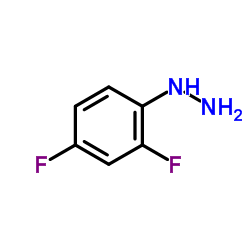
(2,4-Difluorophenyl)hydrazine structure
|
Common Name | (2,4-Difluorophenyl)hydrazine | ||
|---|---|---|---|---|
| CAS Number | 40594-30-7 | Molecular Weight | 144.122 | |
| Density | 1.4±0.1 g/cm3 | Boiling Point | 185.1±30.0 °C at 760 mmHg | |
| Molecular Formula | C6H6F2N2 | Melting Point | 65 °C | |
| MSDS | N/A | Flash Point | 65.7±24.6 °C | |
| Name | (2,4-Difluoro-phenyl)-hydrazine |
|---|---|
| Synonym | More Synonyms |
| Density | 1.4±0.1 g/cm3 |
|---|---|
| Boiling Point | 185.1±30.0 °C at 760 mmHg |
| Melting Point | 65 °C |
| Molecular Formula | C6H6F2N2 |
| Molecular Weight | 144.122 |
| Flash Point | 65.7±24.6 °C |
| Exact Mass | 144.049911 |
| PSA | 38.05000 |
| LogP | 1.70 |
| Vapour Pressure | 0.7±0.4 mmHg at 25°C |
| Index of Refraction | 1.580 |
Synonym: Section 2 - COMPOSITION, INFORMATION ON INGREDIENTS
Risk Phrases: 20/21/22 36/37/38 Section 3 - HAZARDS IDENTIFICATION EMERGENCY OVERVIEW
Harmful by inhalation, in contact with skin and if swallowed. Irritating to eyes, respiratory system and skin. Potential Health Effects Eye: Causes eye irritation. Skin: Causes skin irritation. Harmful if absorbed through the skin. Ingestion: Harmful if swallowed. May cause irritation of the digestive tract. Inhalation: Harmful if inhaled. Causes respiratory tract irritation. Chronic: Not available. Section 4 - FIRST AID MEASURES Eyes: Flush eyes with plenty of water for at least 15 minutes, occasionally lifting the upper and lower eyelids. Get medical aid. Skin: Get medical aid. Flush skin with plenty of water for at least 15 minutes while removing contaminated clothing and shoes. Ingestion: Get medical aid. Wash mouth out with water. Inhalation: Remove from exposure and move to fresh air immediately. If not breathing, give artificial respiration. If breathing is difficult, give oxygen. Get medical aid. Notes to Physician: Section 5 - FIRE FIGHTING MEASURES General Information: As in any fire, wear a self-contained breathing apparatus in pressure-demand, MSHA/NIOSH (approved or equivalent), and full protective gear. Extinguishing Media: Use water spray, dry chemical, carbon dioxide, or chemical foam. Section 6 - ACCIDENTAL RELEASE MEASURES General Information: Use proper personal protective equipment as indicated in Section 8. Spills/Leaks: Vacuum or sweep up material and place into a suitable disposal container. Section 7 - HANDLING and STORAGE Handling: Avoid breathing dust, vapor, mist, or gas. Avoid contact with skin and eyes. Storage: Store in a cool, dry place. Store in a tightly closed container. Section 8 - EXPOSURE CONTROLS, PERSONAL PROTECTION Engineering Controls: Facilities storing or utilizing this material should be equipped with an eyewash facility and a safety shower. Use adequate ventilation to keep airborne concentrations low. Exposure Limits CAS# 40594-30-7: Personal Protective Equipment Eyes: Not available. Skin: Wear appropriate protective gloves to prevent skin exposure. Clothing: Wear appropriate protective clothing to prevent skin exposure. Respirators: Follow the OSHA respirator regulations found in 29 CFR 1910.134 or European Standard EN 149. Use a NIOSH/MSHA or European Standard EN 149 approved respirator if exposure limits are exceeded or if irritation or other symptoms are experienced. Section 9 - PHYSICAL AND CHEMICAL PROPERTIES Physical State: Solid Color: beige Odor: characteristic odor pH: Not available. Vapor Pressure: Not available. Viscosity: Not available. Boiling Point: Not available. Freezing/Melting Point: 63 - 65 deg C Autoignition Temperature: Not available. Flash Point: Not available. Explosion Limits, lower: Not available. Explosion Limits, upper: Not available. Decomposition Temperature: Not available. Solubility in water: Specific Gravity/Density: Molecular Formula: C6H6F2N2 Molecular Weight: 144 Section 10 - STABILITY AND REACTIVITY Chemical Stability: Not available. Conditions to Avoid: Incompatible materials. Incompatibilities with Other Materials: Strong oxidizing agents. Hazardous Decomposition Products: Nitrogen oxides, carbon monoxide, carbon dioxide, fluorine, hydrogen fluoride gas. Hazardous Polymerization: Has not been reported Section 11 - TOXICOLOGICAL INFORMATION RTECS#: CAS# 40594-30-7 unlisted. LD50/LC50: Not available. Carcinogenicity: 1-(2,4-Difluorophenyl)hydrazine - Not listed by ACGIH, IARC, or NTP. Section 12 - ECOLOGICAL INFORMATION Section 13 - DISPOSAL CONSIDERATIONS Dispose of in a manner consistent with federal, state, and local regulations. Section 14 - TRANSPORT INFORMATION IATA Shipping Name: TOXIC SOLID, ORGANIC, N.O.S.* Hazard Class: 6.1 UN Number: 2811 Packing Group: III IMO Shipping Name: TOXIC SOLID, ORGANIC, N.O.S. Hazard Class: 6.1 UN Number: 2811 Packing Group: III RID/ADR Shipping Name: TOXIC SOLID, ORGANIC, N.O.S. Hazard Class: 6.1 UN Number: 2811 Packing group: III Section 15 - REGULATORY INFORMATION European/International Regulations European Labeling in Accordance with EC Directives Hazard Symbols: XN Risk Phrases: R 20/21/22 Harmful by inhalation, in contact with skin and if swallowed. R 36/37/38 Irritating to eyes, respiratory system and skin. Safety Phrases: S 26 In case of contact with eyes, rinse immediately with plenty of water and seek medical advice. S 36/37/39 Wear suitable protective clothing, gloves and eye/face protection. WGK (Water Danger/Protection) CAS# 40594-30-7: No information available. Canada None of the chemicals in this product are listed on the DSL/NDSL list. CAS# 40594-30-7 is not listed on Canada's Ingredient Disclosure List. US FEDERAL TSCA CAS# 40594-30-7 is not listed on the TSCA inventory. It is for research and development use only. SECTION 16 - ADDITIONAL INFORMATION N/A |
| Hazard Codes | Xn:Harmful; |
|---|---|
| Risk Phrases | R20/21/22;R36/37/38 |
| Safety Phrases | S26-S36/37 |
| WGK Germany | 3 |
| HS Code | 2928000090 |
|
~98% 
(2,4-Difluoroph... CAS#:40594-30-7 |
| Literature: Banner, Bruce Lester; Bilotta, Joseph Anthony; Fotouhi, Nader; Gillespie, Paul; Goodnow, Robert Alan; Hamilton, Matthew Michael; Haynes, Nancy-Ellen; Kowalczyk, Agnieszka; Mayweg, Alexander; Myers, Michael Paul; Pietranico-Cole, Sherrie Lynn; Scott, Nathan Robert; Thakkar, Kshitij Chhabilbhai; Tilley, Jefferson Wright Patent: US2007/49632 A1, 2007 ; Location in patent: Page/Page column 25 ; US 20070049632 A1 |
|
~% 
(2,4-Difluoroph... CAS#:40594-30-7 |
| Literature: Syntex (U.S.A.) LLC Patent: US6316466 B1, 2001 ; |
| HS Code | 2928000090 |
|---|---|
| Summary | 2928000090 other organic derivatives of hydrazine or of hydroxylamine VAT:17.0% Tax rebate rate:9.0% Supervision conditions:none MFN tariff:6.5% General tariff:20.0% |
| (2,4-Difluorophenyl)hydrazine |
| MFCD00013383 |
| Hydrazine, (2,4-difluorophenyl)- |
| 1-(2,4-Difluorophenyl)hydrazine |
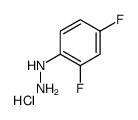
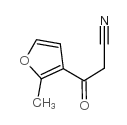

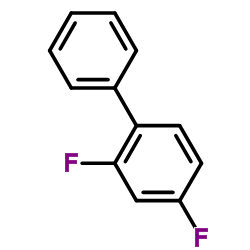 CAS#:37847-52-2
CAS#:37847-52-2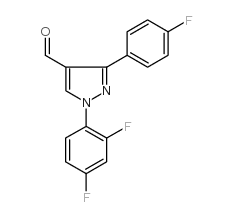 CAS#:618098-78-5
CAS#:618098-78-5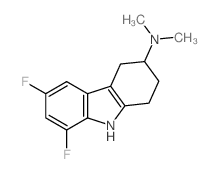 CAS#:40594-09-0
CAS#:40594-09-0